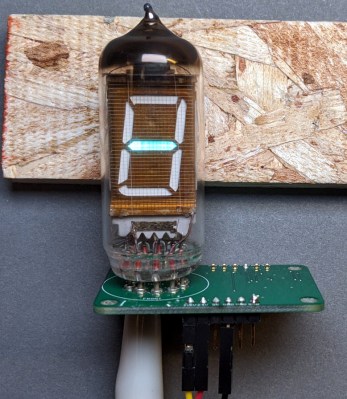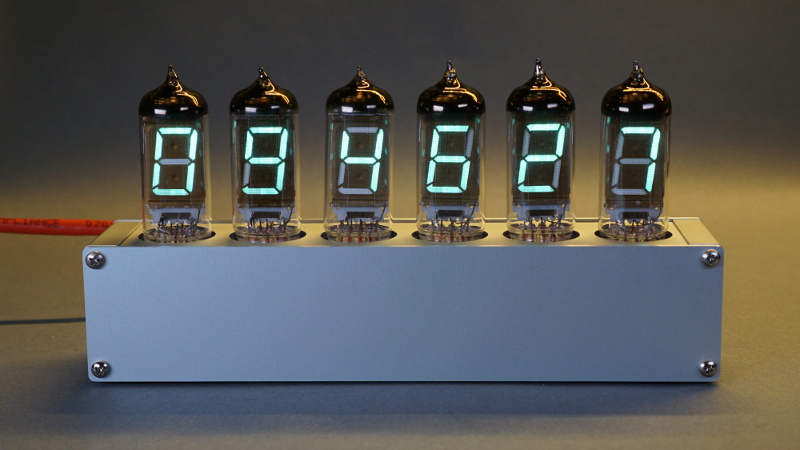The elegance of Power over Ethernet (PoE) is that you can provide network connectivity and power over a single cable. Unfortunately not nearly enough hardware seems to support this capability, forcing intrepid hackers to take matters into their own hands. The latest in this line of single-cable creations is this beautiful Vacuum Fluorescent Display (VFD) clock from [Glen Akins].

One of the key advantages VFDs have over their Nixie predecessors is greatly reduced energy consumption, and after [Glen] ran the numbers, he saw that a display using six VFD tubes could easily be powered with standard PoE hardware. With this information, he started designing the PCB around the early 1990s era IV-12 tube, which has the advantage of being socketed so he could easily remove them later if necessary.
[Glen] first had to create a schematic and PCB footprint for the IV-12 tube that he could import into Eagle, which he was kind enough to share should anyone else be working with these particular tubes down the line. After a test of the newly designed socket was successful, he moved onto the rest of the electronics.
The clock is powered by a Microchip PIC18F67J60, which connects to the Ethernet network and pulls the current time down from NTP. After seeing so many clocks use an ESP to connect to the Internet over WiFi, there’s something refreshing about seeing a wired version. The tube segments are driven by a HV5812, also Microchip branded. Lastly, [Glen] used a number of DC/DC converters to generate the 1.5 V, 3.3 V, 5 V, and 25 V necessary to drive all the electronics and VFDs.
We absolutely love the simplicity of this clock, from its sleek aluminum enclosure to that single RJ45 jack on the back. But if you’re looking for something with a bit more flash, [Glen] also put together some PoE Christmas lights over the holidays which share a number of design elements with this project.
[Thanks to Irish for the tip.]
















“precessessors” That was a struggle to say to myself! Love those VFD tubes though!
Reduced energy consumption? I’m not sure that’s necessarily true.
IN12a nixie: 2.5mA @ 180V. = 0.45 W
VFD: 100mA @1.5V or the heater, PLUS 5mA@25V per segment PLUS 17mA@25V for the grid, so for all 7 segments on:
0.15W for heater, 1.3W for segment to be on.
Admittedly, the efficiency of the boost converters are an issue. But the basic premise is wrong.
Agreed, though cant say for sure until the step up stages are thrown into the equation. The topologies for each application will be greatly different (boost for vfd, likely flyback for nixie), and since the boost ratios are an order of magnitude apart I have a feeling that looking at raw consumption of the tubes themselves isn’t sufficient to say which system would consume more power.
I did not expect them to draw that much current. But for sure I like the appearance of the 7 seg VFD much more than the Nixies. I like the color more and that the number stays in the same plane.
But, that’s the charm of the nixie – the way the digits hide behind one another. Also the way they shift a little left or right, up or down, so that e.g the curvey tops of the 0, 2, 8 and 9 don’t eclipse one another. It’s tec that could have been done in the 1880s or something
I make clocks with both of them. They both have their charms :-) Another advantage with the seven segment ones (apart from being cheaper also) is that you can display some letters too!
Nixies are slightly easier (imho) to switch (single high-voltage NPN transistor per cathode), whereas the VFDs require either a NPN/PNP high side switch pair, or a specialised VFD driver IC.
If the filament side is set at -HV, you don’t need push/pull drivers and can get away with pull down resistors to the filament. I used small PMOS with 47K pull down resistor network for mine. It is fast enough for multiplexed displays.
+5V, 0V, -20V, filament (floating supply) sits on -18V (drop the -20V with a couple of diodes and a load resistor), PMOS connected to +5V with pull down to -20V.
The main reason I didn’t end up doing that is that I use the cheap and nasty dc-dc converter boards from China, and the input and output grounds are the same, so generating -V is harder to achieve…
If you want numbers in the same plane, may as well just use an LED seven segment. I like the nixies for their old quirks and color and infidelities; the way you can look as close as you can at the glowing cathodes and can’t quite tell where the number ends and vacuum begins. It just kind of diffuses into a perfect halo, a strange and subtle gradient of color. And the way they all march when they change to a different number. It’s mesmerizing. But that’s just me. For VFDs, they are certainly cool—but except for a couple really weird ones, I don’t see a significant visual distinction from boring old LED segmented displays. The exceptions are really amazing, though. I got a few in my collection I really like for sure.
My one use for VFDs isn’t even one of the cool tubes. I grabbed one of those ever-present 2×20 VFD displays for my bedside clock. It’s the jankiest thing in the world because it is a bunch of wires on a breadboard with a Teensy3.0, humidity+temp sensor, barometric pressure/altitude sensor, and an RTC. It obviously displays the time (with seconds!), date, relative humidity, barometric pressure, and temperature on the display, which is just leaned up against the side of the breadboard for ugly-tastic effect. The funny thing is, I have gotten so used to it being there, looking like a mess of wires for a bomb’s timer circuit, that I have just never gotten around to building a case for it.
It’s really kinda sad that I rely on it for telling the time while in bed and getting the general idea of how “shocky” the day is gonna be (yeah, low humidity and I don’t mix well… I hate being zapped for touching random metal things throughout the day) and whether or not it might rain. I really do like the brightness of the display, though, and there is just something nostalgic about that VFD blue.
I have built several VFD clocks in the “old days”. Be warned, they dim over time and have to be replaced.
Hi Russell, I have a clock with 6 VFD tubes that I’ve had running continuously since I got it in the mid 90’s and they have indeed gotten much dimmer. They are Futaba DG10S1. Four are labeled as 6CA and two are 4DA. Can they be changed to other size/type of tubes or do I need to replace them with the same ones? I’d really appreciate any advice you can share. Thanks!